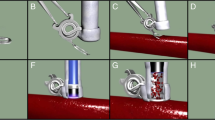Abstract
Background
One of the most difficult procedures through a deep and narrow surgical corridor is tying a knot following microsuturing, even though microvascular suturing is a fundamental technique for neurovascular surgeons.
Methods
A novel technique replacing the conventional knot-tying method was devised. The proposed clip-knotting technique uses an aneurysm clip to hold both remaining ends of a thread that is sutured in a running manner.
Conclusions
The proposed clip-knotting technique can facilitate the microsuturing procedure for intracranial arterial repair in a deep and narrow operative field.


Similar content being viewed by others
References
Park J, Hwang YH, Huh S, Kang DH, Kim Y (2014) Minimally invasive and rapid surgical embolectomy (MIRSE) as rescue treatment following failed endovascular recanalization for acute ischemic stroke. Acta Neurochir (Wien) 156:2041–2049
Park J, Hwang YH, Kim Y (2009) Extended superciliary approach for middle cerebral artery embolectomy after unsuccessful endovascular recanalization therapy: technical note. Neurosurgery 65:E1191–E1194
Park J, Kang DH, Chun BY (2011) Superciliary keyhole surgery for unruptured posterior communicating artery aneurysms with oculomotor nerve palsy: maximizing symptomatic resolution and minimizing surgical invasiveness. J Neurosurg 115:700–706
Park J, Woo H, Kang DH, Sung JK, Kim Y (2011) Superciliary keyhole approach for small unruptured aneurysms in anterior cerebral circulation. Neurosurgery 68(2 Suppl Operative):300–309
Ramos-Zúñiga R, Velázquez H, Barajas MA, López R, Sánchez E, Trejo S (2002) Trans-supraorbital approach to supratentorial aneurysms. Neurosurgery 51:125–131
Reisch R, Perneczky A (2005) Ten-year experience with the supraorbital subfrontal approach through an eyebrow skin incision. Neurosurgery 57(4 Suppl):242–255
Conflicts of interest
None.
Disclosure
The author reports no conflict of interest concerning the materials or methods used in this study or the findings.
Author information
Authors and Affiliations
Corresponding author
Additional information
Key points
1. The clip-knotting technique is useful in minimally invasive surgery including a superciliary keyhole approach.
2. Tying a knot following microsuturing is difficult in a deep and narrow operative field.
3. It can be replaced by the proposed clip-knotting technique.
4. This is applied for intracranial arterial repair.
5. A needle with a short (5-cm) thread is used.
6. Microvascular suturing is performed in a running manner.
7. The running stitch is pulled tight to approximate the edges of the arterial lesion.
8. An aneurysm clip is applied to hold both threads in place.
9. The closing power of an aneurysm clip to hold a suture without slippage can be checked using mosquito forceps.
10. Postoperative and follow-up angiograms are required.
Electronic supplementary material
Below is the link to the electronic supplementary material.
(WMV 31193 kb)
Rights and permissions
About this article
Cite this article
Park, J. Clip-knotting technique for intracranial arterial suturing through deep and narrow surgical corridors—how I do it. Acta Neurochir 157, 769–771 (2015). https://doi.org/10.1007/s00701-015-2350-7
Received:
Accepted:
Published:
Issue Date:
DOI: https://doi.org/10.1007/s00701-015-2350-7




